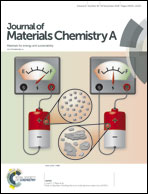Synthesis of glycopolymer nanosponges with enhanced adsorption performances for boron removal and water treatment†
Abstract
The high-affinity interactions between cis-diols and boric/boronic acid have been widely employed as a tool for carbohydrate analysis, protein separation and boron removal. Herein we report the design and synthesis of cyclodextrin-scaffolded glycopolymers as bifunctional nanosponges for boron removal and water treatment for the first time. Different glycopolymer nanosponges (GNs) have been successfully synthesized from monosaccharides and β-cyclodextrin via a combination of a cross-linking reaction, Fischer glycosylation and a click reaction. Such functional GNs are mesoporous polymer frameworks with cis-diol-containing saccharides immobilized on the surface, which have exhibited selective adsorption behaviour towards boric acid depending on the structure of the GNs and the loaded saccharides. The GNs have also shown remarkable adsorption rates and capacities for an organic dye as a model pollutant in this work. Secondary bonding, such as hydrogen bonding and van der Waals forces between the immobilized saccharides and the adsorbates is believed to be responsible for the significantly enhanced adsorption rates and capacities. Such bifunctional materials may exhibit potential applications in seawater desalination and water treatment.



 Please wait while we load your content...
Please wait while we load your content...